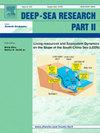波斯湾和阿曼湾短爪蟹物种丰富度格局
IF 3
3区 地球科学
Q2 OCEANOGRAPHY
Deep-sea Research Part Ii-topical Studies in Oceanography
Pub Date : 2025-07-25
DOI:10.1016/j.dsr2.2025.105508
引用次数: 0
摘要
波斯湾是一个浅海、半封闭的边缘海盆,具有独特的地质历史和恶劣的环境条件,并在更新世冰期与印度洋间歇性连接。短爪蟹构成了波斯湾动物群的一个多样化组成部分,在不同的栖息地分布不均匀。人们对波斯湾和阿曼湾螃蟹动物群的生物多样性和区域生物地理数据了解甚少,很少纳入全球生物多样性数据库。在此,我们通过绘制波斯湾和阿曼湾262种短爪蟹的区域分布图,并将数据与开放获取的生物多样性数据库相结合,解决了这一不足。我们使用了QGIS 3.24.3和r4.2.2软件包来绘制和分析分布记录。我们的分析显示,波斯湾的短爪蟹的多样性指标比阿曼湾高。聚类分析表明,伊朗海岸与波斯湾和阿曼湾的阿拉伯海岸相对不同。伊朗沿海水域,特别是霍尔木兹海峡和格什姆岛附近,六边形细胞α物种丰富度分布和丰富度格局较高。波斯湾短囊蟹的分布和物种丰富度与温度(°C)和方解石(mol.m-3)呈正相关,与溶解氧(mol.m-3)负相关。虽然我们的分析不承认波斯湾是一个特有的中心,但强调它是一个重要的外围区域,对西北印度洋短爪蟹的多样性和分布有重要影响。我们认为,目前的结果揭示了在保护代表性不足和生态独特地区(如波斯湾)的海洋生物多样性的保护行动中需要考虑的新见解。本文章由计算机程序翻译,如有差异,请以英文原文为准。
Species richness patterns of brachyuran crabs in the Persian Gulf and the Gulf of Oman
The Persian Gulf is a shallow, semi-enclosed marginal sea basin characterized by a distinct geological history, harsh environmental conditions, and intermittent connection with the Indian Ocean during the Pleistocene glacial periods. Brachyuran crabs constitute a diverse component of the Persian Gulf fauna, distributed unevenly in the various habitats. The biodiversity and regional biogeographic data for the Persian Gulf and Gulf of Oman crab fauna are still poorly understood and rarely incorporated into global biodiversity databases. Here, we have addressed this shortfall by mapping the regional distributions of 262 species of brachyuran crabs in the Persian Gulf and the Gulf of Oman and incorporating the data with open-access biodiversity databases. We used QGIS 3.24.3 and R 4.2.2 packages for mapping and analyzing the distribution records. Our analyses revealed that the Persian Gulf exhibits proportionally higher diversity metrics than the Gulf of Oman for brachyuran crabs. Cluster analysis revealed that the Iranian coasts are relatively differentiated from the Arabian coasts of the Persian Gulf and the Gulf of Oman. The distribution and alpha species richness patterns per hexagonal cells were higher in the Iranian coastal waters, particularly around the Strait of Hormuz and Qeshm Island. Furthermore, the distribution and species richness of the Persian Gulf brachyuran crabs were positively correlated with temperature (°C) and calcite (mol.m-3), while negatively correlated with dissolved oxygen (mol.m-3). Although our analyses did not recognize the Persian Gulf as a center of endemism, but highlighted it as an important peripheral region with significant influences on the present-day diversity and distribution of northwestern Indian Ocean brachyuran crabs. We believe that the present results reveal new insights to be considered in conservation actions to protect marine biodiversity in underrepresented and ecologically unique regions such as the Persian Gulf.
求助全文
通过发布文献求助,成功后即可免费获取论文全文。
去求助
来源期刊
CiteScore
6.40
自引率
16.70%
发文量
115
审稿时长
3 months
期刊介绍:
Deep-Sea Research Part II: Topical Studies in Oceanography publishes topical issues from the many international and interdisciplinary projects which are undertaken in oceanography. Besides these special issues from projects, the journal publishes collections of papers presented at conferences. The special issues regularly have electronic annexes of non-text material (numerical data, images, images, video, etc.) which are published with the special issues in ScienceDirect. Deep-Sea Research Part II was split off as a separate journal devoted to topical issues in 1993. Its companion journal Deep-Sea Research Part I: Oceanographic Research Papers, publishes the regular research papers in this area.

 求助内容:
求助内容: 应助结果提醒方式:
应助结果提醒方式:


